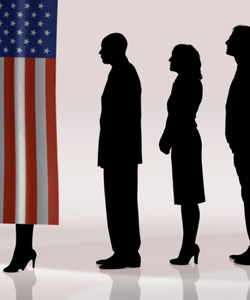
June 1, 2011 – What are the prospects for a constitutional challenge to Wisconsin’s new law requiring photo ID for voters? As Danish physicist Niels Bohr observed, prediction is difficult – especially when it’s about the future. But the temptation to look ahead is irresistible, so I offer the following: It’s a long shot. Here’s why.

The U.S. Supreme Court recently addressed a constitutional challenge to Indiana’s voter ID requirement in Crawford v. Marion County Election Board, 553 U.S. 181 (2008). A 6-3 majority rejected a facial challenge to the law. Justices Souter, Breyer, and Ginsburg dissented. There are three important things to note about Justice Stevens’ majority opinion.
First, the court declined to apply strict scrutiny or, for that matter, specify any particular level of scrutiny for challenges to voter identification schemes. While recognizing that voting restrictions must be related to voter qualifications, it eschewed any litmus test for evaluating the burden imposed by such restrictions. Those burdens must, it said, be justified by relevant and legitimate state interests ‘sufficiently weighty to justify the limitation.’ Id. at 191, citing Norman v. Reed, 502 U.S. 279, 288-289 (1992). The standard is both eminently surmountable and readily manipulated.
Second, in applying this standard, the court was relatively unmoved by arguments that there is little evidence of the in-person voter impersonation that photo ID is designed to prevent. Notwithstanding the absence of a single instance of such fraud in Indiana1, the court concluded that the state’s interests in preventing fraud, maintaining accurate voter rolls, modernizing election practice, and promoting public confidence in the electoral process were sufficiently weighty to justify the burdens reflected in the record before the Court.
Third, the court found that those interests were sufficient notwithstanding its recognition of certain of the burdens normally said to flow from photo ID requirements. It acknowledged, for example, that certain persons lacked such ID and would have to travel to relatively distant licensing centers – often without public transportation. It recognized that such persons, who may well be elderly or indigent, would be required to incur the expense and trouble of obtaining birth certificates or other documents necessary to obtain the required identification.2 None of this was enough to outweigh the state’s interest in combating fraud and promoting public confidence.
Finally, three justices in the majority, while finding the burdens placed on the franchise to be insufficiently severe to sustain a facial challenge, left open the possibility that, under different circumstances, an “as applied” challenge might be successful. Chief Justice Roberts, Justice Stevens, and Justice Kennedy made clear that their conclusion was based on the nature of the burdens revealed by the record before it. Perhaps some additional evidence of burden – a larger percentage of voters without photo identification, some greater inconvenience in obtaining identification or more narrow set of exceptions – would lead to a different result for one or more of these justices. It seems unlikely given that there appears to be nothing about Indiana that makes it more or less burdensome for those without photo identification to obtain it, but the argument may be made.
Not all of the justices in the Crawford majority would be open to such an argument. Justices Scalia, Thomas, and Alito wrote separately to make clear that, in their view, only severe and discriminatory burdens are subject to strict scrutiny and that all other restrictions are to be subjected to a deferential “important regulatory interests” standard. Id. at 204 citing Burdick v. Takushi, 504 U.S. 428, 433-434 (1992). In the view of these three, “[o]rdinary and widespread burdens, such as those requiring ‘nominal effort’ of everyone, are not severe.” Id. at 205 citing Clingman v. Beaver, 544 U.S. 581, 591, 593-597 (2005). That a burden imposed on everyone has a disparate impact on some does not raise constitutional concerns.
So where does this leave us?
The composition of the court has changed. Assuming that Justices Breyer and Ginsburg would continue to hold that a scheme such as Indiana’s was unconstitutional and would be joined by Justices Sotomayor and Kagan, the audience for an argument based on a “differing impact” of a law like Wisconsin’s would be Chief Justice Roberts and Justice Kennedy.
Just what this differing impact would be is unclear. Perhaps a “better” record of burden could be created. In the wake of its passage, critics of the new law noted, for example, that Indiana apparently had more motor vehicle licensing centers at which an ID card might be obtained. But, as noted above, the record in Crawford tracked the normal arguments against photo identification. The opening left by the majority opinion may be more theoretical than actual.
Of course, Wisconsin’s law is similar to Indiana’s but not identical. It contains exemptions that Indiana’s law did not but lacks at least one – a blanket exemption for indigency3 – that the Indiana statute provided. As Judge Posner once said, even the much-sought “cow case” (one that is “on all fours” with the matter at issue) will involve a different cow. In addition, there is always the prospect for a challenge under the Wisconsin Constitution which may be amenable to an interpretation that provides broader protection for individual rights, although, as an empirical matter, such interpretations are relatively rare.
So, a long shot but maybe not a foregone conclusion.
About the author
Rick Esenberg, Harvard 1981, teaches Wisconsin Constitution and Election Law courses at Marquette University Law School and is president of the Wisconsin Institute for Law & Liberty. He writes and speaks frequently on matters of law and public policy and runs the Shark and Shepherd blog (www.sharkandshepherd.blogspot.com).
Endnotes
1 The court did note limited evidence of such fraud in other states and in American lore.
2 The statute did permit the casting of a provisional ballot without the requisite identification if the voter executed an affidavit of indigency, although a voter would have to travel to his or her county seat to do so.
3 Wisconsin’s law provides, for example, liberalized procedures for absentee voting for certain persons who are hospitalized or reside in residential care or similar facilities.
